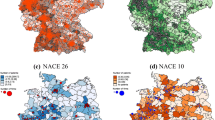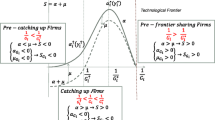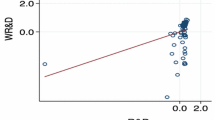Abstract
This paper aims at assessing the magnitude of R&D spillover effects on large international R&D companies’ productivity growth. In particular, we investigate the extent to which R&D spillover effects are intensified by both geographic and technological proximities between spillover generating and receiving firms. We also control for the firm’s ability to identify, assimilate and absorb the external knowledge stock. The results estimated by means of panel data econometric methods (system GMM) indicate a positive and significant impact of both types of R&D spillovers and of absorptive capacity on productivity performance.
Similar content being viewed by others
Notes
Griliches (1979) operates a distinction between pure knowledge spillovers and rent spillovers. The latter arise because new goods and services are purchased at less than their full quality-adjusted prices.
See Cincera (1998) for more details as regards the content of this database.
Any observation for which R&D intensity is less than 0.2% or greater than 50%, net sales per worker, capital stock per worker and R&D capital per worker is above or below three times the interdecile range of the median, the growth rate of net sales is less than minus 90% or greater than 300% or for which the growth rate of labor, capital and R&D stocks is less than minus 60% or greater than 240% has been removed. In addition, we only take firms with observations available for each year over the period. All in all, this leads to a balanced panel of 808 firms compared to the raw unbalanced one of 1,125 firms.
Thanks to the USPTO patent classification system, it is possible to identify the technological classes to which patents are assigned. In order to construct the technological proximity measures, we use the higher level classification proposed by Hall et al. (2001) which consists of 36 two-digit technological categories (see Appendix 1).
Orlando (2000) consulted the Directory of American Research and Technology 1993 which reports the location of firms’ corporate headquarters as well as the location and composition of their R&D. It follows that about 87% of the companies of a representative sample carry out their R&D at the same place as their corporate headquarter location.
According to the authors, ‘embodied knowledge’, i.e. the non-codified knowledge attached to people, does not diffuse passed a certain distance which the authors estimate to be of 300 km.
In a same vein, if spillovers depend on the technological distance between firms, then the more two firms are closed in the technological space, the more spillovers are important. This question has already been extensively examined in previous studies (Jaffe 1986, 1988; Capron and Cincera 1998; Cincera 2005) and is not investigated further here.
The framework developed by Griffith et al. (2003) is based on the interaction between Research employment and the gap between the level of total factor productivity (TFP) of a given industry and the industry with the highest TFP. Cassiman and Veugelers (2002) and Schmidt (2005) use direct measures of absorptive capacities from innovation surveys.
This particular choice of 300 km for the distance is motivated by the results of Bottazzi and Peri (2003). The authors find no evidence of spillovers outside this distance-range, which is robust to several specifications and controls.
See Griliches and Mairesse (1995) for a discussion.
See Blundell and Bond (1998) for a discussion about the instruments available for the first-differenced equations.
Note that in practice, some instruments can be dropped due to collinearity between them.
Corresponding GMM F.D. results are reported in the Table in Appendix 6.
As pointed out by Capron and Cincera (1998), this can be explained by the fact that we use net sales instead of value added for measuring the output in Eq. 6 and we do not include raw materials in this equation due to data unavailability. Assuming constant returns to scale should bring an elasticity associated with the raw materials of about 0.3–0.4.
See Appendix 4.
Note that introducing twice the firms’ own R&D stocks, i.e. \(\Updelta \hbox{K\,ln\,Ts}+\Updelta \hbox{K\,ln\,Tsg},\) instead of \(\Updelta \hbox{K}(\hbox{ln\,Ts}+\hbox{ln\,Tsg}),\) leads to inconclusive results as regards the interaction terms.
References
Arellano, M., & Bover, O. (1995). Another look at the instrumental-variable estimation of error-components models. Journal of Econometrics, 68, 29–52.
Blundell, R. W., & Bond, S. R. (1998). Initial conditions and moment restrictions in dynamic panel data models. Journal of Econometrics, 87, 115–143.
Bottazzi, L., & Peri, G. (2003). Innovation and spillovers in regions: Evidence from European patent data. European Economic Review, 47, 687–710.
Capron, H., & Cincera, M. (1998). Exploring the spillover impact on productivity of world-wide manufacturing firms. Annales d’Economie et de Statistique, 49/50, 565–587.
Cassiman, B., & Veugelers, R. (2002). R&D cooperation and spillovers: Some empirical evidence from Belgium. American Economic Review, 92(4), 1169–1184.
Cincera, M. (1998). Economic and technological performances of international firms. PhD thesis, Université Libre de Bruxelles.
Cincera, M. (2005). Firms’ productivity growth and R&D spillovers: An analysis of alternative technological proximity measures. Economics of Innovation and New Technology, 14(7), 657–682.
Cincera M., B. van Pottelsberghe de la Potterie (2001). International R&D Spillovers: A survey. Cahiers Economiques de Bruxelles, 169, 3–32.
Cohen, W. M., & Levinthal, D. A. (1989). Innovation and learning: The two faces of R&D. The Economic Journal, 99(3), 569–96.
Greunz, L. (2003). Geographically and technologically mediated knowledge spillovers between European regions. The Annals of Regional Science, 37, 657–680.
Griffith, R., Van Reenen, R. J. (2003). R&D and absorptive capacity: Theory and empirical evidence. The Scandinavian Journal of Economics, 105(1), 99–118.
Griliches, Z. (1979). Issues in assessing the contribution of R&D to productivity growth. Bell Journal of Economics, 10, 92–116.
Griliches, Z. (1992). The search for R&D spillovers. Scandinavian Journal of Economics, 94, 29–48.
Griliches, Z., & Mairesse, J. (1995). Production functions: The search for identification. NBER Working Paper N.5067, Cambridge: National Bureau of Economic Research.
Grossman, G. M., & Helpman, E. (1991). Innovation and growth in the global economy. Cambridge: MIT Press.
Grunfeld, L. A. (2004). The multiple faces of R&D: Absorptive capacity effects and different sources of spillovers. Norwegian Institute of International Affairs.
Hall, B. H., Jaffe, A. B., & Trajtenberg, M. (2001). The NBER patent citations data file: Lessons, insights and methodological tools. NBER Working Paper N. 8498.
Jaffe, A. B. (1986). Technological opportunity and spillovers of R&D: Evidence from firms’ patents, profits and market value. American Economic Review, 76(5), 984–1001.
Jaffe, A. B. (1988). R&D intensity and productivity growth. Review of Economics and Statistics, 70, 431–437.
Jaffe, A. B. (1989). Characterizing the ‘Technological Position’ of firms, with application to quantifying technological opportunity and research spillovers. Research Policy, 18, 87–97.
Jaffe A. B., & Trajtenberg M. (1996). Flows of knowledge from universities and federal labs: Modeling the flow of patent citations over time and across institutional and geographic boundaries. NBER Working Paper N.5712, National Bureau of Economic Research, Inc.
Jaffe, A. B., & Trajtenberg, M. (1999). International knowledge flows: Evidence from patent citation. Economics of Innovation and New Technology, 8, 105–136.
Jaffe, A. B., Trajtenberg, M., & Henderson, R. (1993). Geographic localization of knowledge spillovers as evidenced by patent citations. The Quarterly Journal of Economics, 108(3), 577–598.
Kinoshita, Y. (2000). R&D and technology spillovers via FDI: Innovation and absorptive capacity. The William Davidson Institute at the University of Michigan Business School, Working Paper N. 349.
Maurseth, P. B., & Verspagen, B. (2002). Knowledge spillovers in Europe: A patent citations analysis. Scandinavian Journal of Economics, 104(4), 531–545.
Mohnen, P. (1996). R&D externalities and productivity growth. STI Review, 18, 39–66.
Orlando, M. J. (2000). On the importance of geographic and technological proximity for R&D spillovers: An empirical investigation. Federal Reserve Bank of Kansas City, RWP 00-02.
Romer, P. M. (1990). Endogenous technological change. Journal of Political Economy, 98(5), 71–102.
Schmidt, T. (2005). Absorptive capacity—one size fits all? a firm—level analysis of absorptive capacity for different kinds of knowledge. Industrial Organization, 0510010, Economics Working Paper Archive EconWPA.
Acknowledgements
The authors received helpful suggestions and comments from two anonymous referees, Lydia Greunz, Pierre Mohnen, Abdul Noury and participants at the AEA Conference on ‘Innovations and Intellectual Property Values’ at Université Paris I, October, 20–21, 2005.
Author information
Authors and Affiliations
Corresponding author
Appendix
Appendix
Rights and permissions
About this article
Cite this article
Aldieri, L., Cincera, M. Geographic and technological R&D spillovers within the triad: micro evidence from US patents. J Technol Transf 34, 196–211 (2009). https://doi.org/10.1007/s10961-007-9065-8
Published:
Issue Date:
DOI: https://doi.org/10.1007/s10961-007-9065-8




